SATURN ASTRA 2009 Owners Manual
Manufacturer: SATURN, Model Year: 2009, Model line: ASTRA, Model: SATURN ASTRA 2009Pages: 314, PDF Size: 1.94 MB
Page 231 of 314

Vehicle Capacity Weight:The number of designated
seating positions multiplied by
150 lbs (68 kg) plus the
rated cargo load. SeeLoading
the Vehicle on page 8-30.
Vehicle Maximum Load on
the Tire
:Load on an individual
tire due to curb weight,
accessory weight, occupant
weight, and cargo weight.
Vehicle Placard
:A label
permanently attached to a
vehicle showing the vehicle’s
capacity weight and the
original equipment tire size
and recommended in�ation
pressure. See “Tire and Loading
Information Label” under
Loading the Vehicle on
page 8-30.
In�ation - Tire Pressure
Tires need the correct amount of
air pressure to operate effectively.
Notice:Do not let anyone tell
you that under-in�ation or
over-in�ation is all right. It is
not. If your tires do not have
enough air (under-in�ation),
you can get the following:
Too much �exing
Too much heat
Tire overloading
Premature or irregular wear
Poor handling
Reduced fuel economy
If your tires have too much air
(over-in�ation), you can get
the following:
Unusual wear
Poor handling
Rough ride
Needless damage from
road hazardsA vehicle speci�c Tire and
Loading Information label is
attached to your vehicle.
This label shows your vehicle’s
original equipment tires and
the correct in�ation pressures for
your tires when they are cold.
The recommended cold tire
in�ation pressure, shown on the
label, is the minimum amount
of air pressure needed to
support your vehicle’s maximum
load carrying capacity.
For additional information
regarding how much weight your
vehicle can carry, and an
example of the Tire and Loading
Information label, seeLoading
the Vehicle on page 8-30.
How you load your vehicle
affects vehicle handling and ride
comfort. Never load your
vehicle with more weight than it
was designed to carry.
Vehicle Service and Care 9-47
ProCarManuals.com
Page 232 of 314
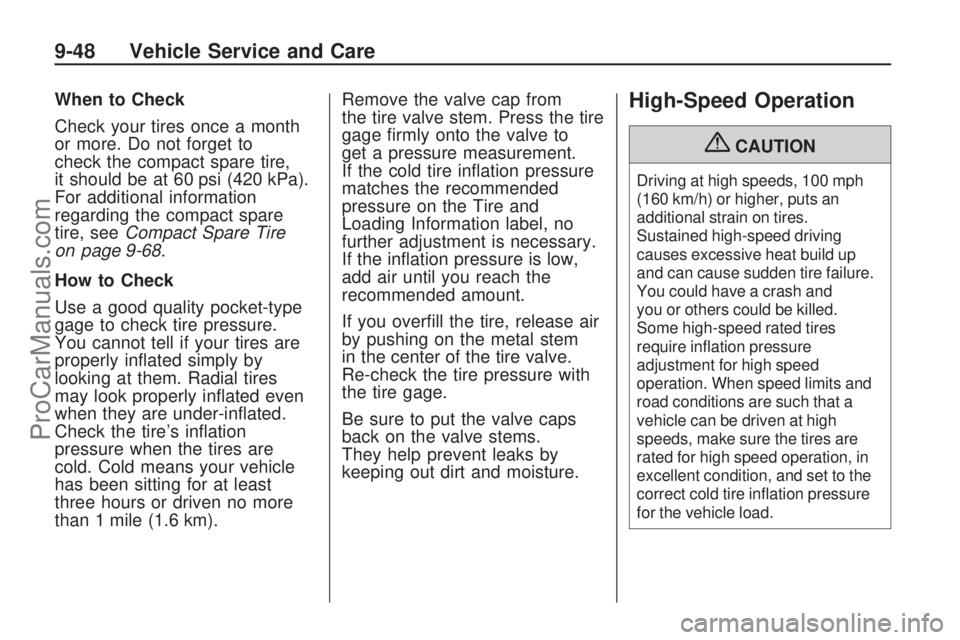
When to Check
Check your tires once a month
or more. Do not forget to
check the compact spare tire,
it should be at 60 psi (420 kPa).
For additional information
regarding the compact spare
tire, seeCompact Spare Tire
on page 9-68.
How to Check
Use a good quality pocket-type
gage to check tire pressure.
You cannot tell if your tires are
properly in�ated simply by
looking at them. Radial tires
may look properly in�ated even
when they are under-in�ated.
Check the tire’s in�ation
pressure when the tires are
cold. Cold means your vehicle
has been sitting for at least
three hours or driven no more
than 1 mile (1.6 km).Remove the valve cap from
the tire valve stem. Press the tire
gage �rmly onto the valve to
get a pressure measurement.
If the cold tire in�ation pressure
matches the recommended
pressure on the Tire and
Loading Information label, no
further adjustment is necessary.
If the in�ation pressure is low,
add air until you reach the
recommended amount.
If you over�ll the tire, release air
by pushing on the metal stem
in the center of the tire valve.
Re-check the tire pressure with
the tire gage.
Be sure to put the valve caps
back on the valve stems.
They help prevent leaks by
keeping out dirt and moisture.High-Speed Operation
{CAUTION
Driving at high speeds, 100 mph
(160 km/h) or higher, puts an
additional strain on tires.
Sustained high-speed driving
causes excessive heat build up
and can cause sudden tire failure.
You could have a crash and
you or others could be killed.
Some high-speed rated tires
require in�ation pressure
adjustment for high speed
operation. When speed limits and
road conditions are such that a
vehicle can be driven at high
speeds, make sure the tires are
rated for high speed operation, in
excellent condition, and set to the
correct cold tire in�ation pressure
for the vehicle load.
9-48 Vehicle Service and Care
ProCarManuals.com
Page 233 of 314

If the vehicle has P205/55R16 size
tires, additional air pressure is
required when driving the vehicle at
speeds of 99 mph (158 km/h) or
higher. Set the cold tire in�ation
pressure to the maximum in�ation
pressure shown on the tire sidewall,
or 32 psi (220 kPa), whichever is
lower. See the example following.
Example:
The maximum load and in�ation
pressure is molded on the tire’s
sidewall, in small letters, near the rim
�ange. It reads something like this:
Maximum load 710 kg (1565 lbs)
350 kPa (51 psi) Max. Press.
For this example, the cold tire
in�ation pressure for high-speed
driving should be set at 32 psi
(220 kPa).
When high-speed driving ends,
return the tire pressure to the
recommended cold in�ation
pressure shown on the Tire and
Loading Information label.SeeLoading the Vehicle on
page 8-30. Tire pressure should be
checked and correctly set when
the tires are cold. SeeInflation - Tire
Pressure on page 9-47.
Tire Pressure Monitor
System
The Tire Pressure Monitor System
(TPMS) uses radio and sensor
technology to check tire pressure
levels. The TPMS sensors monitor
the air pressure in your vehicle’s tires
and transmit tire pressure readings to
a receiver located in the vehicle.
Each tire, including the spare
(if provided), should be checked
monthly when cold and in�ated to
the in�ation pressure recommended
by the vehicle manufacturer on
the vehicle placard or tire in�ation
pressure label. (If your vehicle
has tires of a different size than the
size indicated on the vehicle
placard or tire in�ation pressure
label, you should determine the
proper tire in�ation pressure
for those tires.)As an added safety feature, your
vehicle has been equipped with
a tire pressure monitoring system
(TPMS) that illuminates a low
tire pressure telltale when one or
more of your tires is signi�cantly
under-in�ated.
Accordingly, when the low tire
pressure telltale illuminates, you
should stop and check your tires as
soon as possible, and in�ate them to
the proper pressure. Driving on a
signi�cantly under-in�ated tire
causes the tire to overheat and can
lead to tire failure. Under-in�ation
also reduces fuel efficiency and
tire tread life, and may affect the
vehicle’s handling and stopping
ability.
Please note that the TPMS is
not a substitute for proper tire
maintenance, and it is the driver’s
responsibility to maintain correct tire
pressure, even if under-in�ation
has not reached the level to trigger
illumination of the TPMS low tire
pressure telltale.
Vehicle Service and Care 9-49
ProCarManuals.com
Page 234 of 314

Your vehicle has also been
equipped with a TPMS malfunction
indicator to indicate when the
system is not operating properly.
The TPMS malfunction indicator
is combined with the low tire
pressure telltale. When the system
detects a malfunction, the telltale
will �ash for approximately
one minute and then remain
continuously illuminated.
This sequence will continue upon
subsequent vehicle start-ups
as long as the malfunction exists.
When the malfunction indicator
is illuminated, the system may not
be able to detect or signal low
tire pressure as intended. TPMS
malfunctions may occur for a variety
of reasons, including the installation
of replacement or alternate tires
or wheels on the vehicle that
prevent the TPMS from functioning
properly. Always check the TPMS
malfunction telltale after replacingone or more tires or wheels on
your vehicle to ensure that
the replacement or alternate tires
and wheels allow the TPMS to
continue to function properly.
SeeTire Pressure Monitor
Operation on page 9-51for
additional information.
Federal Communications
Commission (FCC) and
Industry and Science Canada
The Tire Pressure Monitor System
(TPMS) operates on a radio
frequency and complies with
Part 15 of the FCC Rules.
Operation is subject to the
following two conditions:
1. This device may not cause
harmful interference.
2. This device must accept any
interference received, including
interference that may cause
undesired operation.The TPMS operates on a radio
frequency and complies with
RSS-210 of Industry and Science
Canada. Operation is subject to the
following two conditions:
1. This device may not cause
interference.
2. This device must accept any
interference received, including
interference that may cause
undesired operation of the device.
Changes or modi�cations to this
system by other than an authorized
service facility could void
authorization to use this equipment.
9-50 Vehicle Service and Care
ProCarManuals.com
Page 235 of 314

Tire Pressure Monitor
Operation
This vehicle may have a Tire
Pressure Monitor System (TPMS).
The TPMS is designed to warn
the driver when a low tire pressure
condition exists. TPMS sensors
are mounted onto each tire and
wheel assembly, excluding the
spare tire. The TPMS sensors
monitor the air pressure in the
vehicle’s tires and transmit tire
pressure readings to a receiver
located in the vehicle.
When a low tire pressure condition
is detected, the TPMS illuminates
the low tire pressure warning
light located in the instrument
panel cluster.The low tire pressure warning light
comes on at each ignition cycle
until the tires are in�ated to
the correct in�ation pressure.
The low tire pressure warning light
may come on in cool weather
when the vehicle is �rst started, and
then turn off as you start to drive.
This could be an early indicator that
the air pressure in the tire(s) are
getting low and need to be in�ated
to the proper pressure.
You must begin driving before the
TPMS system is operational.
TPMS sensors need to be installed
onto the full-size tire and wheel
assemblies, and the tires adjusted
to the manufacturers’ recommended
tire pressure amount.
A Tire and Load Information label is
attached to the vehicle, and
shows the size of the vehicle’s
original equipment tires and
the correct in�ation pressure for the
tires when they are cold. See
Loading the Vehicle on page 8-30,
for an example of the Tire andLoad Information label and its
location on the vehicle. Also see
Inflation - Tire Pressure on
page 9-47.
The vehicle’s TPMS can warn you
about a low tire pressure condition
but it does not replace normal
tire maintenance. SeeTire
Inspection and Rotation on
page 9-52andTires on page 9-40.
Notice:Liquid tire sealants
could damage the Tire Pressure
Monitor System (TPMS) sensors.
Sensor damage caused by
using a tire sealant is not covered
by your warranty. Do not use
liquid tire sealants.
Each TPMS sensor has a unique
identi�cation code. Any time
you replace one or more of the
TPMS sensors or rotate the
vehicle’s tires, the identi�cation
codes are automatically learned by
the TPMS. This occurs within a
few moments of driving the vehicle
over 19 mph (31 km/h).
Vehicle Service and Care 9-51
ProCarManuals.com
Page 236 of 314
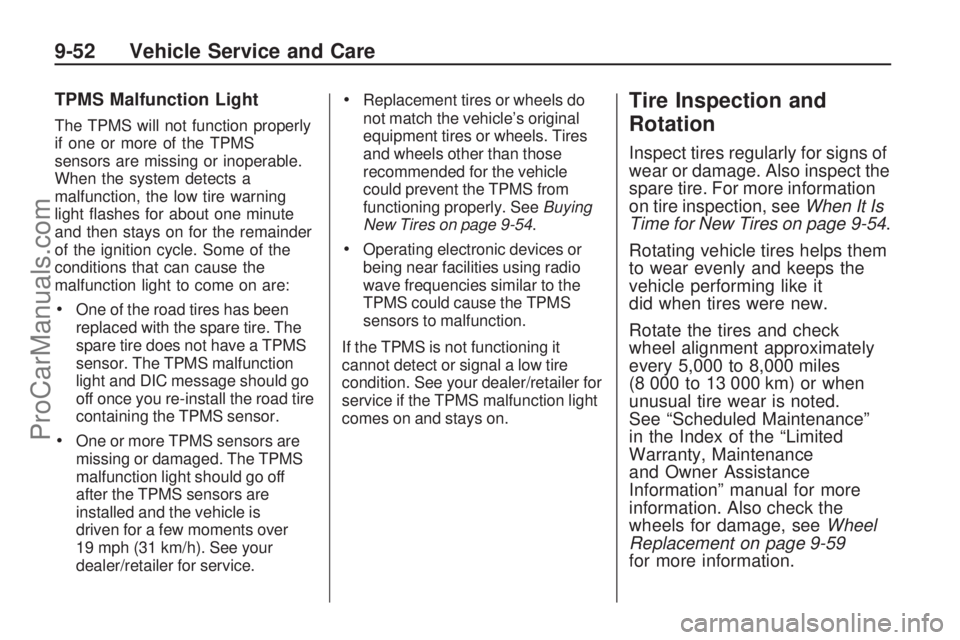
TPMS Malfunction Light
The TPMS will not function properly
if one or more of the TPMS
sensors are missing or inoperable.
When the system detects a
malfunction, the low tire warning
light �ashes for about one minute
and then stays on for the remainder
of the ignition cycle. Some of the
conditions that can cause the
malfunction light to come on are:
One of the road tires has been
replaced with the spare tire. The
spare tire does not have a TPMS
sensor. The TPMS malfunction
light and DIC message should go
off once you re-install the road tire
containing the TPMS sensor.
One or more TPMS sensors are
missing or damaged. The TPMS
malfunction light should go off
after the TPMS sensors are
installed and the vehicle is
driven for a few moments over
19 mph (31 km/h). See your
dealer/retailer for service.
Replacement tires or wheels do
not match the vehicle’s original
equipment tires or wheels. Tires
and wheels other than those
recommended for the vehicle
could prevent the TPMS from
functioning properly. SeeBuying
New Tires on page 9-54.
Operating electronic devices or
being near facilities using radio
wave frequencies similar to the
TPMS could cause the TPMS
sensors to malfunction.
If the TPMS is not functioning it
cannot detect or signal a low tire
condition. See your dealer/retailer for
service if the TPMS malfunction light
comes on and stays on.
Tire Inspection and
Rotation
Inspect tires regularly for signs of
wear or damage. Also inspect the
spare tire. For more information
on tire inspection, seeWhen It Is
Time for New Tires on page 9-54.
Rotating vehicle tires helps them
to wear evenly and keeps the
vehicle performing like it
did when tires were new.
Rotate the tires and check
wheel alignment approximately
every 5,000 to 8,000 miles
(8 000 to 13 000 km) or when
unusual tire wear is noted.
See “Scheduled Maintenance”
in the Index of the “Limited
Warranty, Maintenance
and Owner Assistance
Information” manual for more
information. Also check the
wheels for damage, seeWheel
Replacement on page 9-59
for more information.
9-52 Vehicle Service and Care
ProCarManuals.com
Page 237 of 314
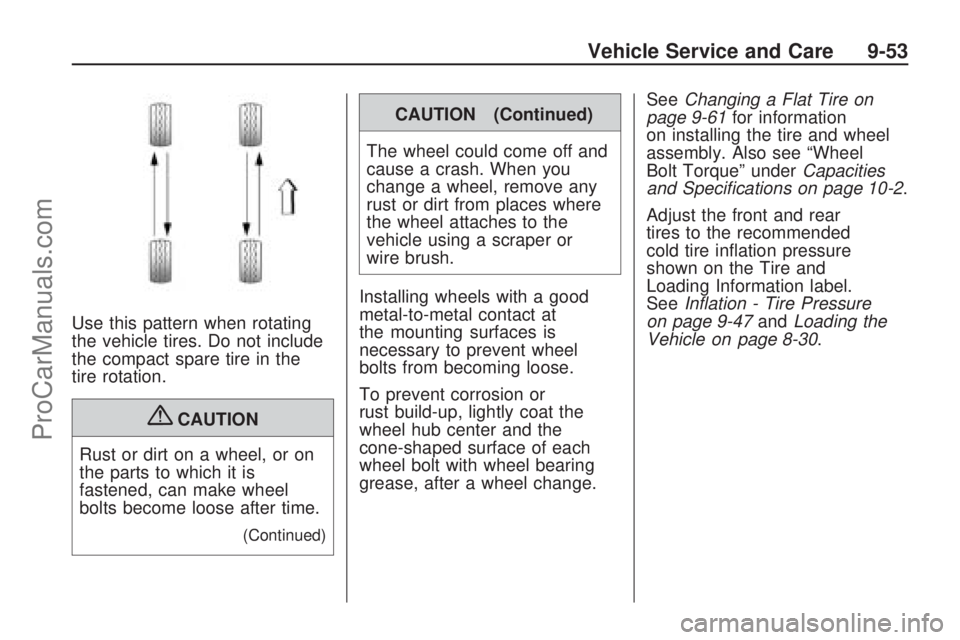
Use this pattern when rotating
the vehicle tires. Do not include
the compact spare tire in the
tire rotation.
{CAUTION
Rust or dirt on a wheel, or on
the parts to which it is
fastened, can make wheel
bolts become loose after time.
(Continued)
CAUTION (Continued)
The wheel could come off and
cause a crash. When you
change a wheel, remove any
rust or dirt from places where
the wheel attaches to the
vehicle using a scraper or
wire brush.
Installing wheels with a good
metal-to-metal contact at
the mounting surfaces is
necessary to prevent wheel
bolts from becoming loose.
To prevent corrosion or
rust build-up, lightly coat the
wheel hub center and the
cone-shaped surface of each
wheel bolt with wheel bearing
grease, after a wheel change.SeeChanging a Flat Tire on
page 9-61for information
on installing the tire and wheel
assembly. Also see “Wheel
Bolt Torque” underCapacities
and Specifications on page 10-2.
Adjust the front and rear
tires to the recommended
cold tire in�ation pressure
shown on the Tire and
Loading Information label.
SeeInflation - Tire Pressure
on page 9-47andLoading the
Vehicle on page 8-30.
Vehicle Service and Care 9-53
ProCarManuals.com
Page 238 of 314
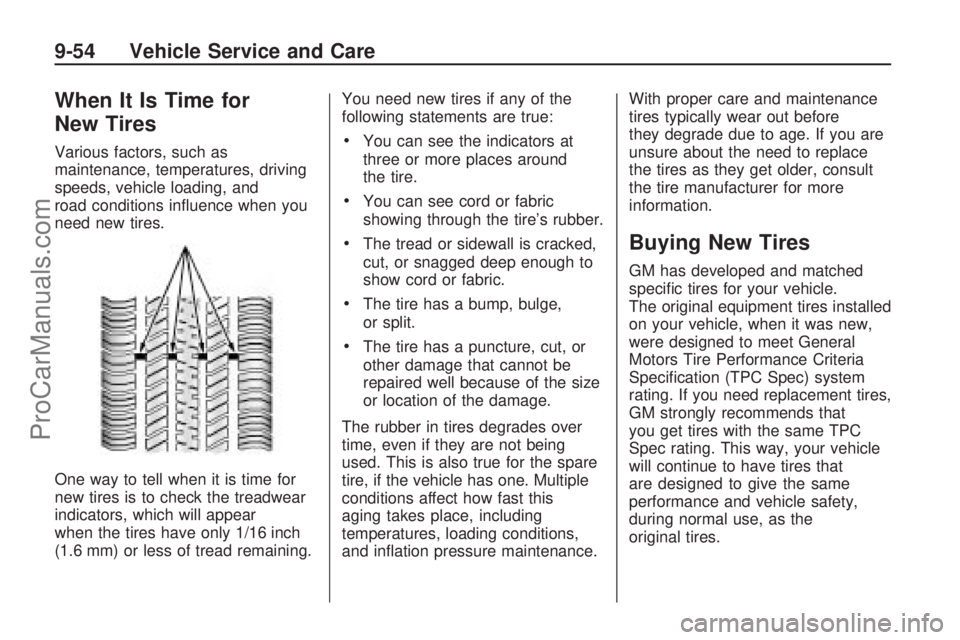
When It Is Time for
New Tires
Various factors, such as
maintenance, temperatures, driving
speeds, vehicle loading, and
road conditions in�uence when you
need new tires.
One way to tell when it is time for
new tires is to check the treadwear
indicators, which will appear
when the tires have only 1/16 inch
(1.6 mm) or less of tread remaining.You need new tires if any of the
following statements are true:You can see the indicators at
three or more places around
the tire.
You can see cord or fabric
showing through the tire’s rubber.
The tread or sidewall is cracked,
cut, or snagged deep enough to
show cord or fabric.
The tire has a bump, bulge,
or split.
The tire has a puncture, cut, or
other damage that cannot be
repaired well because of the size
or location of the damage.
The rubber in tires degrades over
time, even if they are not being
used. This is also true for the spare
tire, if the vehicle has one. Multiple
conditions affect how fast this
aging takes place, including
temperatures, loading conditions,
and in�ation pressure maintenance.With proper care and maintenance
tires typically wear out before
they degrade due to age. If you are
unsure about the need to replace
the tires as they get older, consult
the tire manufacturer for more
information.
Buying New Tires
GM has developed and matched
speci�c tires for your vehicle.
The original equipment tires installed
on your vehicle, when it was new,
were designed to meet General
Motors Tire Performance Criteria
Speci�cation (TPC Spec) system
rating. If you need replacement tires,
GM strongly recommends that
you get tires with the same TPC
Spec rating. This way, your vehicle
will continue to have tires that
are designed to give the same
performance and vehicle safety,
during normal use, as the
original tires.
9-54 Vehicle Service and Care
ProCarManuals.com
Page 239 of 314
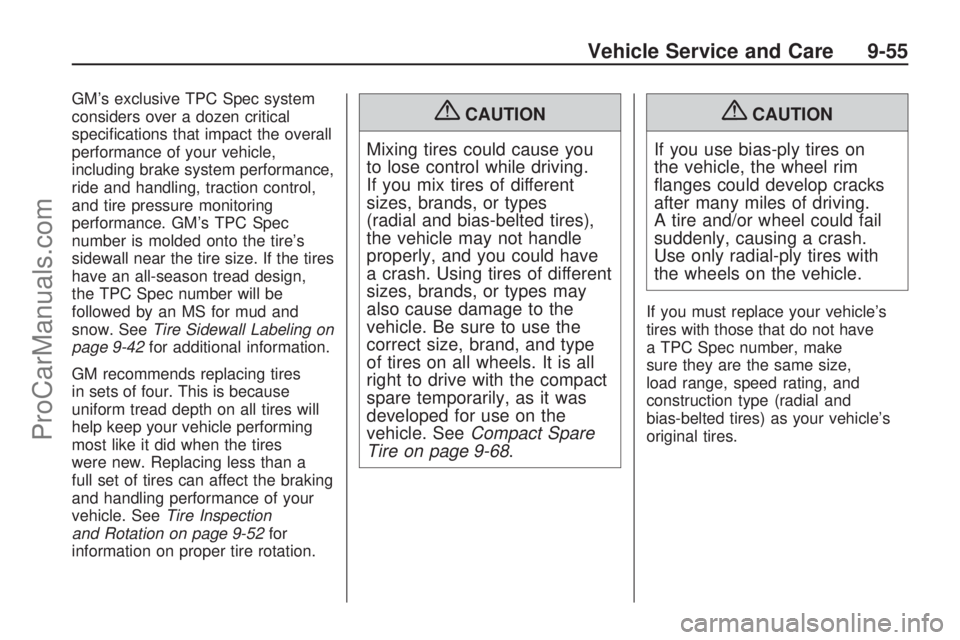
GM’s exclusive TPC Spec system
considers over a dozen critical
speci�cations that impact the overall
performance of your vehicle,
including brake system performance,
ride and handling, traction control,
and tire pressure monitoring
performance. GM’s TPC Spec
number is molded onto the tire’s
sidewall near the tire size. If the tires
have an all-season tread design,
the TPC Spec number will be
followed by an MS for mud and
snow. SeeTire Sidewall Labeling on
page 9-42for additional information.
GM recommends replacing tires
in sets of four. This is because
uniform tread depth on all tires will
help keep your vehicle performing
most like it did when the tires
were new. Replacing less than a
full set of tires can affect the braking
and handling performance of your
vehicle. SeeTire Inspection
and Rotation on page 9-52for
information on proper tire rotation.{CAUTION
Mixing tires could cause you
to lose control while driving.
If you mix tires of different
sizes, brands, or types
(radial and bias-belted tires),
the vehicle may not handle
properly, and you could have
a crash. Using tires of different
sizes, brands, or types may
also cause damage to the
vehicle. Be sure to use the
correct size, brand, and type
of tires on all wheels. It is all
right to drive with the compact
spare temporarily, as it was
developed for use on the
vehicle. SeeCompact Spare
Tire on page 9-68.{CAUTION
If you use bias-ply tires on
the vehicle, the wheel rim
�anges could develop cracks
after many miles of driving.
A tire and/or wheel could fail
suddenly, causing a crash.
Use only radial-ply tires with
the wheels on the vehicle.
If you must replace your vehicle’s
tires with those that do not have
a TPC Spec number, make
sure they are the same size,
load range, speed rating, and
construction type (radial and
bias-belted tires) as your vehicle’s
original tires.
Vehicle Service and Care 9-55
ProCarManuals.com
Page 240 of 314
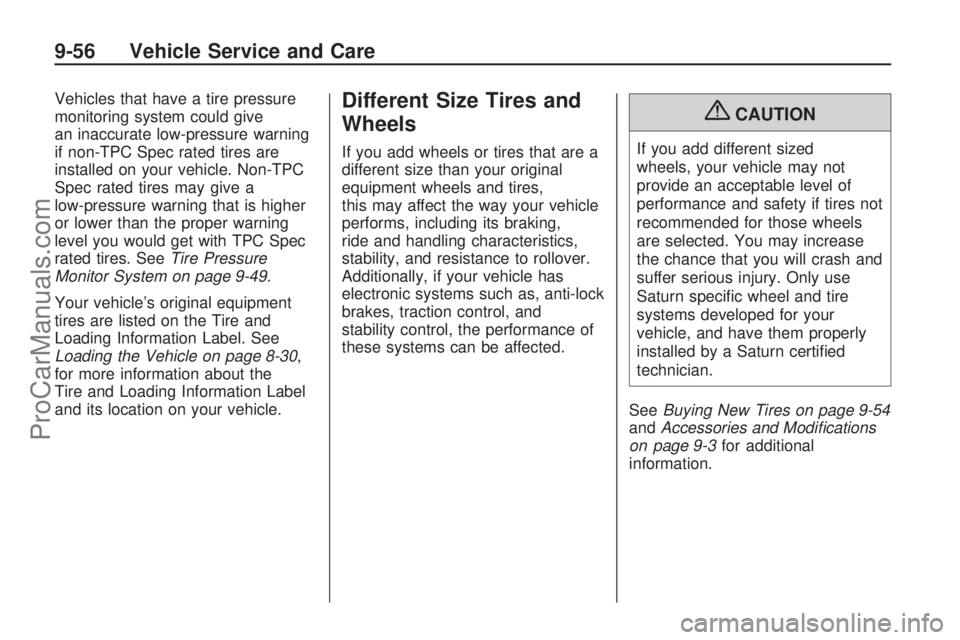
Vehicles that have a tire pressure
monitoring system could give
an inaccurate low-pressure warning
if non-TPC Spec rated tires are
installed on your vehicle. Non-TPC
Spec rated tires may give a
low-pressure warning that is higher
or lower than the proper warning
level you would get with TPC Spec
rated tires. SeeTire Pressure
Monitor System on page 9-49.
Your vehicle’s original equipment
tires are listed on the Tire and
Loading Information Label. See
Loading the Vehicle on page 8-30,
for more information about the
Tire and Loading Information Label
and its location on your vehicle.Different Size Tires and
Wheels
If you add wheels or tires that are a
different size than your original
equipment wheels and tires,
this may affect the way your vehicle
performs, including its braking,
ride and handling characteristics,
stability, and resistance to rollover.
Additionally, if your vehicle has
electronic systems such as, anti-lock
brakes, traction control, and
stability control, the performance of
these systems can be affected.
{CAUTION
If you add different sized
wheels, your vehicle may not
provide an acceptable level of
performance and safety if tires not
recommended for those wheels
are selected. You may increase
the chance that you will crash and
suffer serious injury. Only use
Saturn speci�c wheel and tire
systems developed for your
vehicle, and have them properly
installed by a Saturn certi�ed
technician.
SeeBuying New Tires on page 9-54
andAccessories and Modifications
on page 9-3for additional
information.
9-56 Vehicle Service and Care
ProCarManuals.com